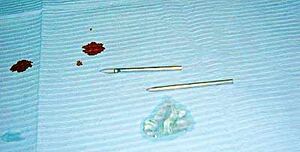Needlestick
Needlestick is when a body artist (or anyone) accidentally pokes themselves with a needle. While working carefully and having well-thought out and practiced procedures greatly reduces the chance of a needlestick, the fact is that sometimes it happens even to the best artists. If there is contaminated blood on that needle, the person who just got stuck is at risk. Wearing gloves can reduce the risk by acting as a "squeegee" on the needle, but especially with hollow bore needles the risk is never eliminated.
HIV and Hepatitis can both be passed via needlestick for example, as can tuberculosis, syphillis, and many other diseases. Needlesticks are very common, with millions of them happening every year (if you include the medical community). Transmission rates for HIV appear to be less than 0.5%. Hepatitis B has a transfer rate of about 2% (one in fifty), although that jumps as high as 40% in the presence of HbeAg (a Hep B antigen) — although you can be (and most piercers are) vaccinated against Hepatitis B. Hepatitis C appears to have a transfer rate between 3% and 10% (between one in thirty and one in ten).
If a needlestick injury occurs you should immediately wash the injury with soap and water (or an alcohol hand cleaning solution if that's not available) — trying to suck or squeeze out the blood or using a snakebite kit probably won't do anything. If possible, find out the person's HIV and Hep status and ask if they have any other bloodborne pathogens that you need to be concerned with. Even if they say "no" to all of that, you should definitely go to your doctor and be regularly tested for HIV and Hep over the next year to ensure you didn't catch anything. Finally, all needlesticks should be documented in your studio records.
